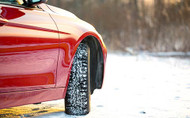How Tires Affect Vehicle Road Test Results
Feb 22nd 2019
You’ve probably seen published road test results from magazines—or seen and heard them as part of online video road tests—and wondered, “Hey, that’s nothing close to what my car does, and I have the same brand and model as the one in the test.”
Well, sort of. Is your car really the same as the vehicle being tested? Model and equipment packages vary so widely, and equipment changes so much from year to year, that the chances are slim that your ride is exactly like the vehicle tested, even if your car and the magazine’s test car look pretty much look the same.

Sometimes, you can be a bit disappointed when you get a vehicle that doesn’t deliver on the promise of the road test numbers. What can differ? Engines, for one. Some models offer everything from small, normally aspirated 4-cylinders to 6-cylinders and even brawny V8s. You better believe the acceleration and fuel mileage test results will vary by engine, especially when power-boosting turbochargers are added to the mix.
Other things can vary, too. Suspension calibrations, such as spring rates and shock damping, and the size of sway bars affect ride, handling and cornering capabilities. Different brake size, caliper styles and pad material can vastly produce different stopping distances and encourage or hinder brake fade. Transmissions—whether manual, automated manual with internal clutches, and traditional torque-converter-equipped automatics—can influence not only acceleration times, but also fuel economy, control and a vehicle’s personality.
Tires Affect Many Test Ratings
The one thing that perhaps influences more performance categories than any other—in fact, just about any performance category—is one of the vehicle’s cheapest components: tires. Think about it: Tires may make up a mere $400-$500 of many vehicles’ total cost and yet can completely change its personality. Even on a high-performance vehicle with tires that might cost $600 apiece, the rubber totals a small fraction of a vehicle’s bottom line. An engine option might cost $4,000 or more. A transmission option might cost $2,000.
Refer to the chart to see how tires influence road test results, and how different tires on an otherwise similar model will change your experience. Performance is likely to change if you buy the same model with different rubber, or switch later to a different style or size tire.
There are not good and bad tire characteristics as much a there are differing characteristics. Better handling is a good characteristic, but it often requires a wider tire that degrades ide quality and sounds louder. If you want a smoother ride and really don’t drive hard, a narrower tire that’s quieter and more comfortable makes total sense, even though many people would say it’s not “as good” a tire.
It all depends on how you drive you car. For example, if you have a Ford Mustang convertible or a Mazda Miata that’s a second car and has summer tires, and you never drive the car in winter, summer tires may be perfect. If you get deep snowfalls and have winter tires for four months a year, the summer tires for the rest of the year also make sense.
Change Tire Sizes, Types Safely
If you buy a car new and it comes with tires and wheels a different size than those on a vehicle described in a published road test, you’ll get different results but you’ll do it safely. That’s because everything is calibrated at the factory to the tire sizes and suspension components on the car. If you change tire type and size and the wheels yourself, however, you must make sure your new tire’s outer diameter is the same as the old tire’s diameter.
| TIRE | CHARACTERISTICS |
| Wider Tires | Narrower Tires |
| Better cornering | Weaker cornering |
| Quicker acceleration | Slower acceleration |
| Shorter braking | Longer braking |
| Harder ride | Softer ride |
| More highway stability | Less highway stability |
| More noise | Less noise |
| Less winter performance (no winter use if summer tire) | More winter performance (unless summer tire) |
| Summer Tires | All-Season Tires |
| Better handling | Weaker handling |
| Three-season use | Year-round use |
| Harder ride | Softer ride |
| Dangerous in snow | Traction in light to moderate snow |
| Fuel Saver Tires | Conventional Tires |
| Higher fuel economy | Lower fuel economy |
| Weaker handling/cornering | Stronger handling/cornering |
| Slower acceleration | Faster acceleration |
| Less road noise | More road noise |
| Longer braking | Shorter braking |
| Weaker rain grip | Stronger rain grip |
| All-Terrain Tires | SUV Highway Tires |
| Can travel off road | Can travel soft road but not off road |
| More traction in gravel, mud, sand, rocky terrain | May handle gravel, light mud; can't handle sand, rock |
| More road noise | Less road noise |
| Lower fuel economy | Higher fuel economy |
| Rougher highway ride | Smoother highway ride |
| Less responsive at speed | More responsive at speed |
| Less straight-line stability at speed | More straight-line stability at speed |
| The descriptions above are generalities. Some tires excel at certain characteristics that most tires in the same class don't. | |
| For instance, some wide, high-performance tires ride softer than competing brands, and some narrower touring tires handle. | |
| Extremely well despite putting less rubber on the road. TireMart.com tries to describe accurately the performance | |
| Characteristics of the tires it sells. |
















